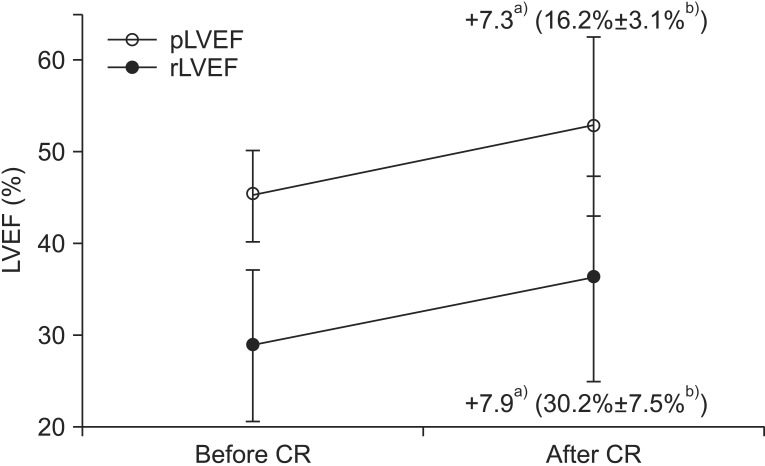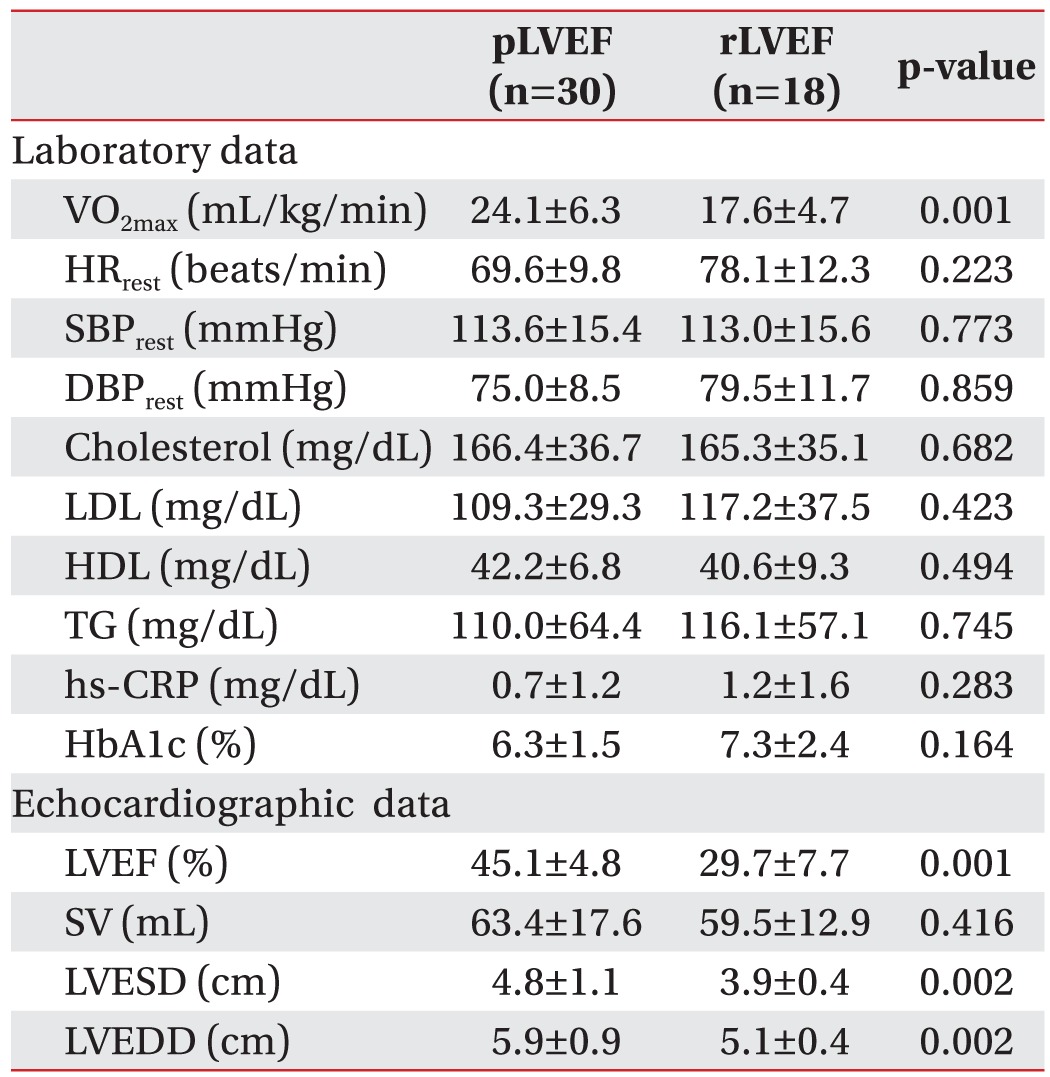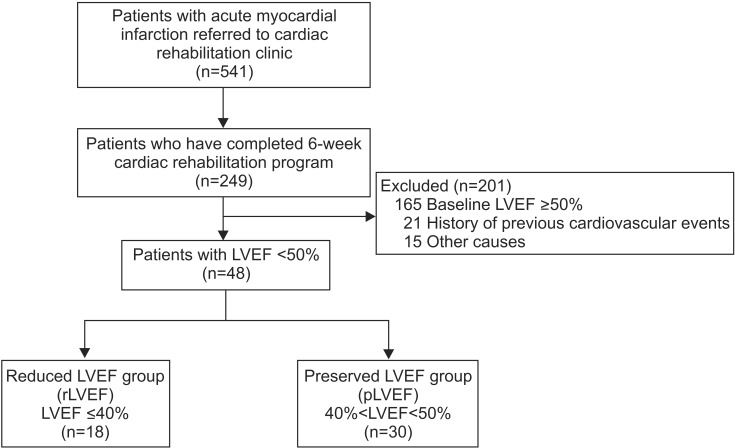1. Hedback B, Perk J, Hornblad M, Ohlsson U. Cardiac rehabilitation after coronary artery bypass surgery: 10-year results on mortality, morbidity and readmissions to hospital. J Cardiovasc Risk 2001;8:153-158. PMID:
11455847.


2. Taylor RS, Brown A, Ebrahim S, Jolliffe J, Noorani H, Rees K, et al. Exercise-based rehabilitation for patients with coronary heart disease: systematic review and meta-analysis of randomized controlled trials. Am J Med 2004;116:682-692. PMID:
15121495.


3. OŌĆÖConnor GT, Buring JE, Yusuf S, Goldhaber SZ, Olmstead EM, Paffenbarger RS, et al. An overview of randomized trials of rehabilitation with exercise after myocardial infarction. Circulation 1989;80:234-244. PMID:
2665973.


4. Dugmore LD, Tipson RJ, Phillips MH, et al. Changes in cardiorespiratory fitness, psychological wellbeing, quality of life, and vocational status following a 12 month cardiac exercise rehabilitation programme. Heart 1999;81:359-366. PMID:
10092561.



5. Sutton MG, Sharpe N. Left ventricular remodeling after myocardial infarction: pathophysiology and therapy. Circulation 2000;101:2981-2988. PMID:
10869273.


6. Dubach P, Myers J, Dziekan G, Goebbels U, Reinhart W, Vogt P, et al. Effect of exercise training on myocardial remodeling in patients with reduced left ventricular function after myocardial infarction: application of magnetic resonance imaging. Circulation 1997;95:2060-2067. PMID:
9133516.


7. Ehsani AA, Biello D, Seals DR, Austin MB, Schultz J. The effect of left ventricular systolic function on maximal aerobic exercise capacity in asymptomatic patients with coronary artery disease. Circulation 1984;70:552-560. PMID:
6478561.


8. Weber KT, Kinasewitz GT, Janicki JS, Fishman AP. Oxygen utilization and ventilation during exercise in patients with chronic cardiac failure. Circulation 1982;65:1213-1223. PMID:
6804111.


9. Kramer N, Susmano A, Shekelle RB. The ŌĆ£false negativeŌĆØ treadmill exercise test and left ventricular dysfunction. Circulation 1978;57:763-768. PMID:
630685.


10. Benge W, Litchfield RL, Marcus ML. Exercise capacity in patients with severe left ventricular dysfunction. Circulation 1980;61:955-959. PMID:
6444854.


11. Port S, McEwan P, Cobb FR, Jones RH. Influence of resting left ventricular function on the left ventricular response to exercise in patients with coronary artery disease. Circulation 1981;63:856-863. PMID:
7471342.


12. Taylor RS, Davies EJ, Dalal HM, Davis R, Doherty P, Cooper C, et al. Effects of exercise training for heart failure with preserved ejection fraction: a systematic review and meta-analysis of comparative studies. Int J Cardiol 2012;162:6-13. PMID:
22664368.


13. Pandey A, Parashar A, Kumbhani DJ, Agarwal S, Garg J, Kitzman D, et al. Exercise training in patients with heart failure and preserved ejection fraction: meta-analysis of randomized control trials. Circ Heart Fail 2015;8:33-40. PMID:
25399909.


14. Reibis R, Jannowitz C, Halle M, Pittrow D, Gitt A, Voller H. Management and outcomes of patients with reduced ejection fraction after acute myocardial infarction in cardiac rehabilitation centers. Curr Med Res Opin 2015;31:211-219. PMID:
25325219.


15. Yancy CW, Jessup M, Bozkurt B, Butler J, Casey DE Jr, Drazner MH, et al. 2013 ACCF/AHA guideline for the management of heart failure: a report of the American College of Cardiology Foundation/American Heart Association Task Force on Practice Guidelines. J Am Coll Cardiol 2013;62:e147-e239. PMID:
23747642.


16. Wyer SJ, Earll L, Joseph S, Harrison J, Giles M, Johnston M. Increasing attendance at a cardiac rehabilitation programme: an intervention study using the Theory of Planned Behaviour. Coron Health Care 2001;5:154-159.

17. Bethell HJ. Exercise in cardiac rehabilitation. Br J Sports Med 1999;33:79-86. PMID:
10205687.



18. Beauchamp A, Worcester M, Ng A, Murphy B, Tatoulis J, Grigg L, et al. Attendance at cardiac rehabilitation is associated with lower all-cause mortality after 14 years of follow-up. Heart 2013;99:620-625. PMID:
23213175.


19. Ali M, Qadir F, Javed S, Khan ZN, Asad S, Hanif B. Factors affecting outpatient cardiac rehabilitation attendance after acute myocardial infarction and coronary revascularization: a local experience. J Pak Med Assoc 2012;62:347-351. PMID:
22755278.

20. Arthur HM, Suskin N, Bayley M, Fortin M, Howlett J, Heckman G, et al. The Canadian Heart Health Strategy and Action Plan: cardiac rehabilitation as an exemplar of chronic disease management. Can J Cardiol 2010;26:37-41. PMID:
20101356.



21. Lloyd-Jones DM, Hong Y, Labarthe D, Mozaffarian D, Appel LJ, Van Horn L, et al. Defining and setting national goals for cardiovascular health promotion and disease reduction: the American Heart AssociationŌĆÖs strategic Impact Goal through 2020 and beyond. Circulation 2010;121:586-613. PMID:
20089546.


22. Gaudron P, Eilles C, Kugler I, Ertl G. Progressive left ventricular dysfunction and remodeling after myocardial infarction: potential mechanisms and early predictors. Circulation 1993;87:755-763. PMID:
8443896.


23. Goldstein S, Sharov VG, Cook JM, Sabbah HN. Ventricular remodeling: insights from pharmacologic interventions with angiotensin-converting enzyme inhibitors. Mol Cell Biochem 1995;147:51-55. PMID:
7494555.


24. Pfeffer MA, Braunwald E. Ventricular remodeling after myocardial infarction: experimental observations and clinical implications. Circulation 1990;81:1161-1172. PMID:
2138525.


25. American Association of Cardiovascular and Pulmonary Rehabilitation. Guidelines for cardiac rehabilitation program. 2nd ed. Champaign: Human Kinetics; 1995.
26. Adamopoulos S, Coats AJ, Brunotte F, Arnolda L, Meyer T, Thompson CH, et al. Physical training improves skeletal muscle metabolism in patients with chronic heart failure. J Am Coll Cardiol 1993;21:1101-1106. PMID:
8459063.


27. Sullivan MJ, Higginbotham MB, Cobb FR. Exercise training in patients with severe left ventricular dysfunction: hemodynamic and metabolic effects. Circulation 1988;78:506-515. PMID:
3409495.


28. Hambrecht R, Niebauer J, Fiehn E, Kalberer B, Offner B, Hauer K, et al. Physical training in patients with stable chronic heart failure: effects on cardiorespiratory fitness and ultrastructural abnormalities of leg muscles. J Am Coll Cardiol 1995;25:1239-1249. PMID:
7722116.


29. Giannuzzi P, Tavazzi L, Temporelli PL, Corra U, Imparato A, Gattone M, et al. Long-term physical training and left ventricular remodeling after anterior myocardial infarction: results of the Exercise in Anterior Myocardial Infarction (EAMI) trial. EAMI Study Group. J Am Coll Cardiol 1993;22:1821-1829. PMID:
8245335.


30. Jette M, Heller R, Landry F, Blumchen G. Randomized 4-week exercise program in patients with impaired left ventricular function. Circulation 1991;84:1561-1567. PMID:
1914097.


32. Chen YM, Li ZB, Zhu M, Cao YM. Effects of exercise training on left ventricular remodelling in heart failure patients: an updated meta-analysis of randomised controlled trials. Int J Clin Pract 2012;66:782-791. PMID:
22805270.


33. Lee BC, Chen SY, Hsu HC, Su MY, Wu YW, Chien KL, et al. Effect of cardiac rehabilitation on myocardial perfusion reserve in postinfarction patients. Am J Cardiol 2008;101:1395-1402. PMID:
18471448.


34. Linxue L, Nohara R, Makita S, Hosokawa R, Hata T, Okuda K, et al. Effect of long-term exercise training on regional myocardial perfusion changes in patients with coronary artery disease. Jpn Circ J 1999;63:73-78. PMID:
10084367.


35. Makaryus J, Tobe L, Alharbi M, Kim D, Ershova S, Robi A, et al. Cardiac rehabilitation improves myocardial blood flow reserve as assessed by positron emission tomographic myocardial perfusion imaging. J Am Coll Cardiol 2014;63(12 Suppl): A1017.

36. Lee BC, Hsu HC, Tseng WY, Su MY, Chen SY, Wu YW, et al. Effect of cardiac rehabilitation on angiogenic cytokines in postinfarction patients. Heart 2009;95:1012-1018. PMID:
19304668.


37. Nishi I, Noguchi T, Iwanaga Y, Furuichi S, Aihara N, Takaki H, et al. Effects of exercise training in patients with chronic heart failure and advanced left ventricular systolic dysfunction receiving ╬▓-blockers. Circ J 2011;75:1649-1655. PMID:
21613745.


38. Vanhees L, Stevens A, Schepers D, Defoor J, Rademakers F, Fagard R. Determinants of the effects of physical training and of the complications requiring resuscitation during exercise in patients with cardiovascular disease. Eur J Cardiovasc Prev Rehabil 2004;11:304-312. PMID:
15292764.
















